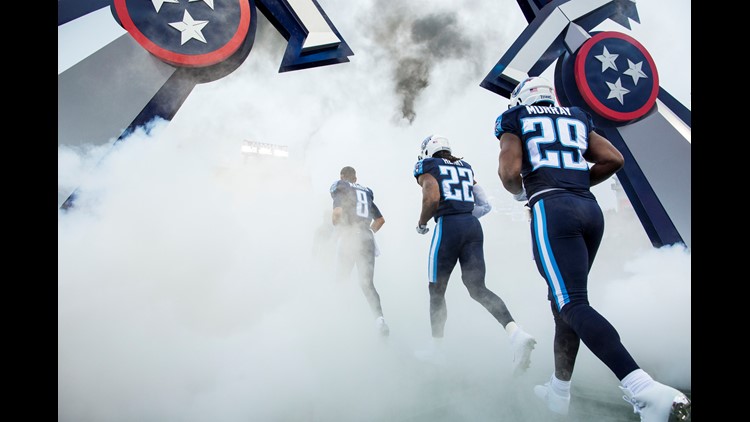DALLAS — The Dallas Cowboys front office made a very wise decision three years ago when they decided to let running back DeMarco Murray test free agency.
Mind you, it was not an easy decision. It was one of those "heart versus brain" type of conflicts. The heart said to keep Murray because he was a locker room staple and undoubtedly his 392 carries for 1,845 yards, both franchise single-season records, and 13 touchdowns were the bulwark of Dallas' 12-4 finish and NFC East title.
However, the brain said to let Murray move along in free agency because those 392 carries took a toll on his lifetime as a running back, even if they never showed up on the injury report. In the 2015 off-season, five of the nine running backs since 1950 who carried 390-plus times in a season suffered a debilitating injury in the next two seasons or were out of football.
The nine running backs are Jamal Anderson, Terrell Davis, Eric Dickerson (who had two seasons with 390-plus carries), Barry Foster, Eddie George, Larry Johnson, Gerald Riggs, James Wilder, and Ricky Williams. Anderson, Davis, Foster, Johnson, and Williams suffered an injury after their big seasons carry wise and were out of football. Williams is somewhat of an exception to the five given he did return to the Dolphins in 2005 after a season being retired, but he also played just one game the next two seasons before finishing off his career from 2008-11.
Murray also had an injury history before he hit his contract season where he was fortuitously able to play all 16 games. Even so, he fractured his left hand on Dec. 14 against the Philadelphia Eagles. Murray was unquestionably tough, but durability was something the front office had to ponder when deciding to sign the 27-year-old to an extension.
"Murray is going to get some peace and see what's out in the market and then we'll talk and see," Cowboys COO Stephen Jones told me on Feb. 28, 2015. "I do believe deep down he'd love to stay in Dallas."
Of course Murray would, but he was looking for a deal to stay in Dallas to the tune of $42 million over five years, which is what the Eagles were willing to give him in free agency. The Cowboys did not budge and said adios to the first running back to have consecutive 1,000 yards rushing seasons since Emmitt Smith.
If the Cowboys had hung onto Murray, the antics of Joseph Randle would not have loomed so heavily over the running-back-by-committee. There would still be meat on the bone, but perhaps a little more than the Cowboys would have liked. Even though Murray wasn't happy in his role in Chip Kelly's offense in Philadelphia, his body did regress to the mean with hamstring and groin injuries throughout the season, one of which sidelined him after his Week 2 showdown with the Cowboys. Murray had 702 yards and six touchdowns on 193 carries in that one season with the Eagles.
The next off-season Philadelphia swapped fourth-round picks with the Tennessee Titans and sent him to Nashville. Murray seemed to return to his old self, as he played another full 16-game season and swelled over the 1,000 yards rushing mark. But his final year, a playoff year at that, would see him battle hamstring injuries. A knee injury also kept him out the season finale and playoffs.
On Friday, Murray retired after seven seasons of pro football. He lasted three seasons after his MVP-caliber season where the Cowboys were a catch away (or was it a fumble away?) from the NFC Championship and maybe more.
Where would Dallas be running back wise? No doubt having Murray on the roster in 2015 may have given the Cowboys locker room a little more leadership and their running attack still has a modicum of the offense's identity. After all, Darren McFadden gained 1,080 in some very limited time behind the Cowboys' offensive line. However, he only scored three rushing touchdowns.
Perhaps Murray gets two or three more, and that is the difference in the Cowboys going 5-11 or 6-10 in a season without Tony Romo and a gimpy Dez Bryant. By the way, that would have pushed the Cowboys into the fifth through 10th overall range. Maybe they do take cornerback Jalen Ramsey from Florida State after all. Maybe they trade back and get Paxton Lynch late in the first round after all. For sure, there is no Ezekiel Elliott and who knows where Dak Prescott would have ultimately ended up.
In the 1990's -- heck, even as late as 2008 -- the Cowboys front office (i.e. owner/president/general manager Jerry Jones) would have signed Murray to an extension because of his contributions to the team. They did it with Marion Barber, and he was oft injured, through no fault of his own, after signed his extension in 2008. Center Andre Gurode made the Pro Bowl in 2006, and the Cowboys signed him to an extension in 2007. He was cut in 2011. Safety Roy Williams signed a four-year contract extension worth $26 million in 2006. Dallas cut him after the 2008 season.
Those moves put the Cowboys in a mini-salary cap hell, not as bad as the one the Triplets had to suffer at the end of the 1990's or Dave Camp had to coach through in the early 2000's, but significant enough that Romo didn't have the protection until it was too late and DeMarcus Ware had to chase championships in Denver.
Letting Murray walk was a hard decision from a sentimental standpoint, but it was a win for the Cowboys front office in that they learned from their mistakes of reward past performance with future money.
Where would you rank Murray's 2014 season in the annals of great years by Cowboys running backs? Debate with Mark about it on Twitter @therealmarklane.



